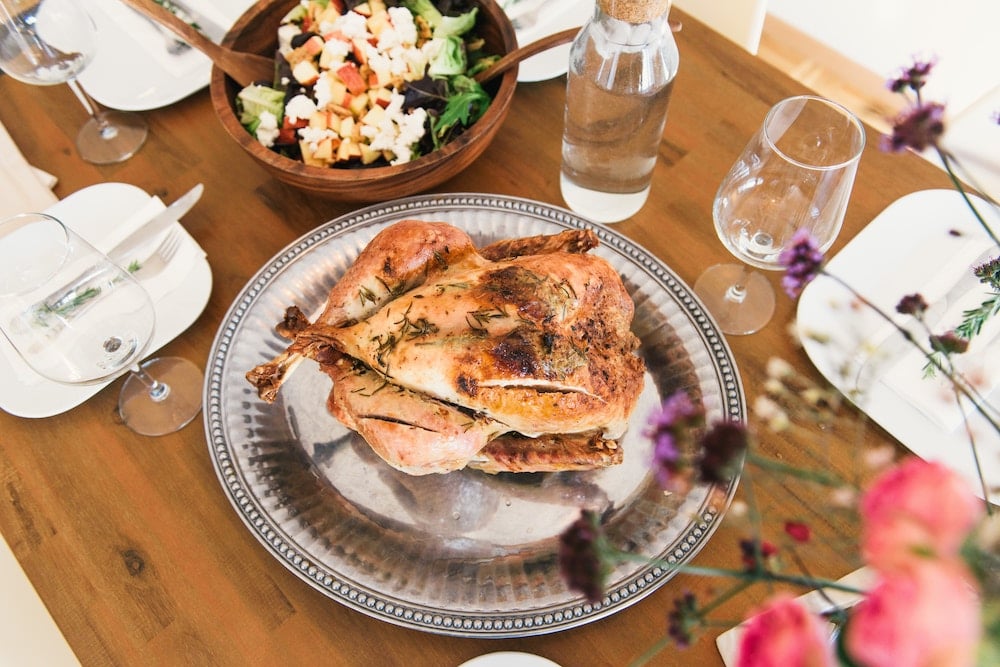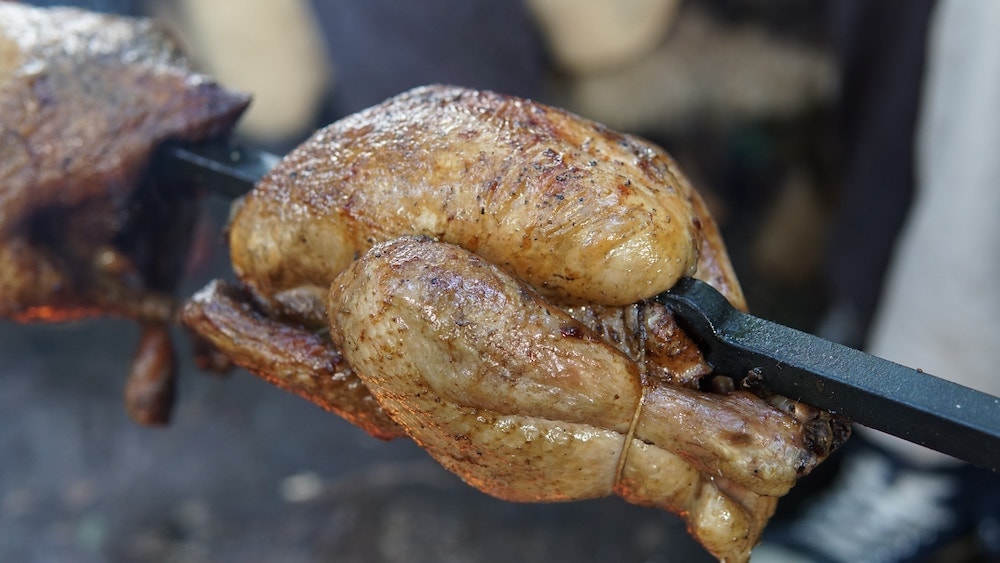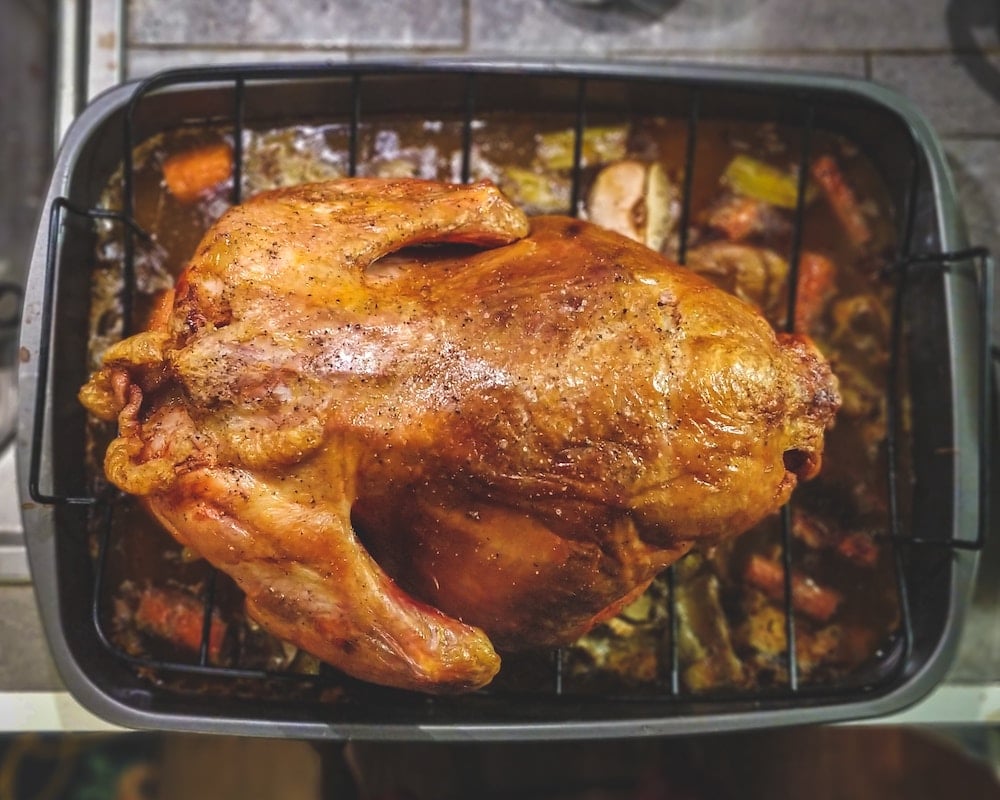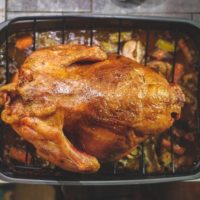How Long and at What Temp Do I Cook a Stuffed Whole Chicken 4.5 Lbs
There's a lot of debate over how long to roast a chicken, and what's the "right way" to do it. What's the ideal temperature? How do you get the crispiest skin? How do you keep the breast from overcooking when the things might be undercooked? Is basting a waste of time? What sort of knife do you need to carve it?

I've roasted a lot of chickens in my lifetime. And after a good deal of trial and error, I've come up with some solid conclusions.
How long to roast a chicken in the oven?
It's super simple to figure out how long to roast a chicken, but people still get hung up on it. Seriously, roasting chickens is one of the top things I get asked about from my students in the Fearless Cooking Club.
The number one problem people have is having the breast dry out. The second problem people have is that the thighs are too raw. What's a well-meaning home cook to do with such a puzzle? Well, I've included all the advice you'll ever need in the list below.
Here is everything you ever needed to know about roasting chickens.
Does the type of chicken matter?
First of all, let's talk chicken selection. You don't need to start with the perfect bird to end up with a finished product you can be proud of. That said, I will always endorse a free range, organic option. I think in the end it not only tastes better, but will also support the kind of world we want to live in the future.
But if you can't afford a $30 locally farmed, pasture raised chicken, don't worry. You can still pull off the perfect roast chicken pretty easily. And I'm really not dogmatic about the whole organic this. In reality, it's expensive and sometimes unrealistic.
This IS important: Buy a chicken that does not have any salt added to it. Companies LOVE to inject commercial birds with all sorts of things like salt, sugar, flavoring, food dye (yes, really), and more.
How do you know if a chicken has all of these things in it? Easy: look at the ingredients. If it says anything other than "chicken," or the nutritional information contains salt and/or sugar, then you've got an additive-laden bird.
IMPORTANT: If you already have a chicken at home with additives added, don't panic! It's fine! Keep reading for what to do with it.
Can you brine a chicken before roasting?
There's one thing you need to do to improve the texture of your chicken, and it's not something you may have considered before: salting ahead of time. (AKA, dry brining your chicken.)
Wet brining — soaking your chicken in salt water — is a huge pain in the butt and almost always makes a mess. I don't recommend wet brining for turkeys, and I don't recommend it for chickens, either.
I prefer dry brining, which is the method I outline below. You literally coat the chicken with salt, sugar, herbs, and spices. That's it.
Do NOT brine a chicken that has been injected with salt or it will be too salty. This includes both the dry brining or wet brining methods. A little salt and pepper on the skin before you cook is all you need. If your chicken contains any "ingredients" on the label besides just chicken, it likely has already been salted by injection.
Time and salt = chicken roasting magic
If you salt your chicken 12 to 24 hours ahead of time, something magical happens. The salt permeates the chicken meat, all the way down to the bone, and that salted meat becomes a lot more forgiving when it comes to overcooking.
That's not to say you can go waaaay over in your chicken roasting time — because a pre-salted chicken can and will definitely still overcook. But if you do salt it ahead of time, the meat will stay moist for a few degrees higher than it would have had you not salted it early. Basically, it gives you more wiggle room.
When you pre-salt your chicken, you're dry-brining it. It's super easy. You basically rub your chicken all over with a fairly generous amount of salt (with herbs, spices, and sugar, if you like), stick it in a bowl, cover it, and let it sit in the fridge overnight. Then you give it a good rinse before putting it in the oven.
A pre-salted bird tastes better, no matter how long you roast your chicken. This is because instead of just carrying salt on the surface of the meat, the salt seasons the bird all the way through to the middle. So each bite has a nice, even lightly salty flavor. It basically seasons the chicken from within.

What if you miss the 24-hour mark?
No problem. Here are some thoughts on salting if you don't have 24 hours
- 24 hours ahead is ideal, but 12 hours is better than no hours
- 2 hours is better than 30 minutes
- Even 30 minutes is better than 10 minutes,
- You get the idea…
Dry brining ratio and method:
Here's the ratio for dry brining.
It's the same as my turkey dry brine, but in a smaller amount for a roast chicken:
- 2 tablespoon kosher salt
- 1 teaspoon brown sugar (optional)
- ½ teaspoon black pepper
Flavorful extras you can add (mix and match — pick two from this list):
- 1 teaspoon chopped fresh sage
- 1 teaspoon finely chopped fresh rosemary
- 1 teaspoon chopped fresh thyme
- 1 teaspoon chopped parsley
- 1 teaspoon finely grated lemon zest
- ½ teaspoon smoked paprika
- ½ teaspoon onion powder
- ½ teaspoon minced garlic
Dry brining instructions for chicken:
Mix everything in a bowl and let sit for 30 minutes. Rub all over your chicken. Place your chicken in a bowl and cover it with plastic wrap. Let rest in the refrigerator for 12-24 hours. Overnight works great.

More details on dry brining roast chicken
I like using using KOSHER SALT. There's a reason for this. Iodized salt can oversalt your bird in the same ratio, because it's way saltier (seriously).
Kosher salt is cheap. You can get a big box from the grocery store for like $2.
You're also welcome to use dried or fresh herbs for brining your roast chicken, but I prefer fresh since they are more flavorful. Just chop them up finely. You can also add dry spices that have been ground to a powder.
It's also worth noting that you can also brine your individual chicken pieces if your bird has been cut into pieces. This includes chicken legs, breasts, thighs, etc. Dry brining is a GREAT way to really maximize the succulent texture of fried chicken.
Rubbing your chicken with fat
I personally love to rub my chicken all over with soft butter before roasting it. Don't go crazy, or the chicken may turn out greasy. But give the chicken a nice massage with 3 tablespoons of soft butter (or olive oil, if you like) inside and outside, and it will self-baste and give you SUPER crispy skin.
If you didn't salt your chicken beforehand, mix 1/2 teaspoon salt into the butter. (Don't do this is you brined your bird!) You can also mix chopped herbs into the butter, like rosemary or thyme. Your chicken will smell even more divine when you're cooking it.

Keep the breast moist and thighs fully cooked
When roasting a chicken, reality is that the breast dries out faster than the thighs. This is because dark meat is biologically more able to hold onto moisture. So how do you get the thighs done without drying out the breast?
You have a few options:
- Cut the bird into individual pieces and remove them as they come to temperature
- Spatchcock the chicken so it cooks more evenly, in a flat layer
- Cook the bird whole but cut off the breast when it's done and keep cooking the thighs
- Start the bird breast-down, then flip it over halfway through roasting
My personal preference for chickens is the last one, starting the bird breast-down and then flipping it over when it's half-cooked.
This allows the thighs to cook faster because they're exposed to more hot air, while the breasts are protected by the pan. Then when you flip the chicken over, the breast get exposed to that same hot air, and the mostly-cooked thighs are protected by the pan. It usually works out pretty well.
Spatchcocking/butterflying your chicken
Spatchcocking (AKA butterflying) is also a great method for even cooking. This cooks the chicken in a flat layer, so everything is exposed to the same amount of ambient heat. You can also set a bed of potatoes and carrots underneath to catch all the juices and keep the chicken from sticking to the pan.
Here's a tutorial video on how to butterfly a chicken, or you can usually ask the meat person at your grocery store to do it.
Should you truss a chicken?
I'll be honest… trussing chickens is annoying. Either I can't find my twine, or I never get the trussing just right… and I always end up pissed off. So I found a better way.
The main point of trussing a chicken for roasting is to keep air from circulating inside the body cavity, which dries out the bird from the inside out. Trussing basically ties the legs closed and stops air from circulating inside.
But you can create the same effect by stuffing a whole lemon, cut into quarters, in the middle of the chicken. Maybe throw a few full sprigs of herbs in there as well.
Not only will your chicken not dry out from the inside, it will smell even more amazing when it's cooking. When you're ready to serve, just fish out the lemon and herbs, then throw them away.
Should you stuff chicken?
No. No. NO!
If you stuff any sort of poultry with stuffing or dressing, it's nearly impossible to make sure the stuffing is at a safe temperature when it's done cooking unless you remove it from the bird and finish cooking it on its own.
Poultry is especially dangerous when it comes to bacteria like salmonella. Anything that touches the raw chicken needs to be cooked to 160°F (71°C) to make it safe to eat.
In order to cook the stuffing or dressing to 160°F (71°C) while it's inside of the bird, you'd need to cook the chicken EXTRA long. This would most certainly dry out the meat. Seriously, you'd need to roast the chicken to like 220°F to make the stuffing safe.
By then the meat is tough like shoe leather.
In the end it's easier, safer, and results in a more desirable meat texture if you just cooking the stuffing on its own, outside of the chicken.
How long do you roast for?
Now, down to the nitty-gritty of time, temperature, and everything else. If you want to know how long to roast a chicken, I've got a list of advice below that will show you how to take your whole chicken and roast it to perfection.
Of course the amount of time depends on a few factors, such as how big your chicken is, how accurate your oven is, and how long it's been out of the fridge. But overall, it's a super easy process and the recipe below will guide you through without any drama. You can even print it out and stick it on your fridge.
I recommend roasting a chicken at 400°F (204°C) for perfect texture and crispy skin, and cooking it to 150°F (66°C). Here's why:
You might be thinking, "150°F isn't a safe temperature for chicken!" But here's the thing: it will keep cooking after you take it out of the oven. After you remove the chicken from the oven, cover it with foil and let it sit 15 minutes. The bird will continue to cook for that entire time and hit a PERFECT 160°F (71°C), and NOT overcook. You're welcome!
And because you brined it ahead of time, the texture will be extra lovely.
Your new best friend: the probe thermometer
Your best friend when roasting a chicken is a probe thermometer, the kind you stick in the oven and attach to an alarm. These AMAZING devices are only $15 at Target or Amazon and will save your butt when it comes to roasting a any sort of meat in the oven or on the grill.
All you need to do is stick the probe in the thickest part of the chicken (the breast), making sure to keep it away from any bones that might throw off the temperature. Then you set the temperature alarm for 150°F (66°C). You'll know it's done when it beeps.
It's super easy. You can walk away, get distracted, and it will remind you when it's done. Sorcery!
A note on roasting veggies in the pan
If you're cooking hard vegetables under the chicken — like potatoes, carrots, turnips, winter squash, etc — they'll usually take longer to cook than the chicken itself.
I solve for this by starting the veggies earlier than the chicken. Place your veggies in the roasting pan or cast iron skillet, then slide them into a hot oven. After 20 minutes, give them a good toss with a spatula to keep them from burning, then set the chicken on top and slide the pan back into the oven.
Also, the smaller you chop your vegetables, the faster they will cook. I shoot for chunks no larger than ½-inch.
Roasting chickens is easy. I promise.
I promise, perfect roast chicken is not difficult. It just takes a little practice and help along the way. The tips below will help you hone your technique so that you're roasting perfect chickens every single time.
I've also added a video to the recipe where I answer a few questions from my student on how to roast a chicken:

-
Roasting pan or cast iron skillet
-
Roasting rack
- 1 whole chicken 3 to 4 pounds
- 2 tablespoons kosher salt
- 1 teaspoon brown sugar optional
- 1/2 teaspoon black pepper
- 3 tablespoons butter or olive oil, at room temperature
-
Larger birds meant for roasting have a heartier taste, while smaller fryers tend to be less flavorful. Organic chickens taste a little better to me, though most people won't be able to tell the difference.
-
Don't worry about trussing your chicken. It's a total pain. Instead, stuff it with a quartered onion or lemon to keep internal airflow to a minimum.
-
Some argue that rubbing the entire bird with fat, inside and out, doesn't affect the flavor, but I disagree. It depends on the fat, though — butter mixed with a heaping dose of salt and herbs will yield a tasty dish indeed.
-
Stuffing some flavored fat (such as butter with salt and herbs) under the skin will help flavor meat, but don't go overboard. Too much fat will just just make the meat greasy. A dab under the skin of each drumstick, thigh, and side of the breast is all you need.
-
If you're cooking hard vegetables under the chicken, like potatoes and carrots, they'll often take longer to cook than the chicken. I solve for this by starting the veggies 20 minutes earlier than the chicken. Throw your veggies in the roasting pan or cast iron skillet, then slide them into a hot oven. After 20 minutes, give them a good toss with a spatula to keep them from burning, then set the chicken on top and slide it back into the oven.
-
You want the entire bird to roast evenly and have crispy skin all over, so consider elevating it off the surface of the roasting pan or cast iron skillet. A small roasting rack will do the trick, which allows air to circulate under the bird – crisping it all the way around. Or get one of those pokey racks that holds the chicken upright, crisping all possible skin. (YES!!!)
-
The jury is in: 400°F (204°C) is the perfect temperature for cooking a whole chicken. You'll get crispy skin and a fairly quick dinner without compromising tenderness.
-
GET A DECENT OVEN THERMOMETER. 'Nuff said. Oven thermostats LIE... and can be up to 40° off. I'm not kidding.
-
The proper cooking time depends on the size of your chicken. A 4-pound chicken should take about 1 to 1-1/2 hours to roast at 400°F (204°C). I highly recommend a probe thermometer, one that stays in the chicken while it cooks and lets you set an alarm for when it reaches the proper temperature. This keeps you from continually opening the oven door, which will greatly increase your cooking time.
-
Basting the bird with the runoff juices won't give you crispier skin. In fact, you'll get limp, soggy skin because it's mostly water you're dumping on the surface of your chicken.
-
Don't waste the juices in the bottom of the pan! Throw some veggies under the chicken to soak up the juices while it cooks. Or reduce in a saucepan with a little white wine, and you've got an amazing sauce.
-
They (whoever "they" are) say that you're supposed to cook a whole chicken to 180°F (82°C), but I find that 160°F (77°C) yields a perfectly moist bird that's still cooked completely through. This means you need to remove the chicken from the oven when it's at about 150°F (66°C) and then let it carryover cook on its own to 160°F. I promise, it will work.
Also, make sure to measure in the thickest part of the breast.
-
Let your bird rest for 15 minutes after you take it out of the oven. A good nap will allow carryover cooking to finish its job, while also allowying moisture to redistribute through the bird.
-
The easiest way to guarantee that pieces of breast will be moist is to let them soak in the chicken's juices for a few minutes after they've been cut. This includes the fatty runoff from what you've rubbed over the surface or stuffed under the skin.
Calories: 80 kcal | Carbohydrates: 1 g | Protein: 1 g | Fat: 9 g | Saturated Fat: 5 g | Cholesterol: 23 mg | Sodium: 3564 mg | Fiber: 1 g | Sugar: 1 g | Vitamin A: 262 IU | Calcium: 3 mg
And I've even got two posts on how to make perfect pork chops:
- How long do you roast pork chops for?
- Check out these perfectly cooked pan-to-oven roast pork chops.
This content was originally posted on FearlessFresh.com.
How Long and at What Temp Do I Cook a Stuffed Whole Chicken 4.5 Lbs
Source: https://fearlessfresh.com/how-long-to-roast-a-chicken/
0 Response to "How Long and at What Temp Do I Cook a Stuffed Whole Chicken 4.5 Lbs"
Post a Comment